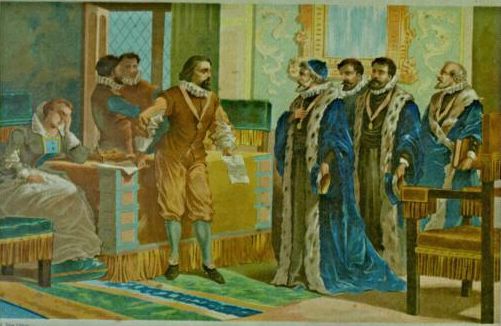
Francis Bacon was an English philosopher and statesman who served as Attorney General and as Lord Chancellor of England. His works are credited with developing the scientific method and remained influential through the scientific revolution. Bacon has been called the father of empiricism. His works argued for the possibility of scientific knowledge based only upon inductive reasoning and careful observation of events in nature. Most importantly, he argued science could be achieved by use of a sceptical and methodical approach whereby scientists aim to avoid misleading themselves. Although his practical ideas about such a method, the Baconian method, did not have a long–lasting influence, the general idea of the importance and possibility of a sceptical methodology makes Bacon the father of the scientific method. This method was a new rhetorical and theoretical framework for science, the practical details of which are still central in debates about science and methodology.
Bacon was the first recipient of the Queen’s counsel designation, which was conferred in 1597 when Elizabeth I of England reserved Bacon as her legal advisor. After the accession of James VI and I in 1603, Bacon was knighted. He was later created Baron Verulam in 1618 and Viscount St. Alban in 1621. Because he had no heirs, both titles became extinct upon his death in 1626, at 65 years. Bacon died of pneumonia, with one account by John Aubrey stating that he had contracted the condition while studying the effects of freezing on the preservation of meat. He is buried at St Michael’s Church, St Albans, Hertfordshire.
Born: January 22
Died: April 9
Mother: Lady Anne
Father: Sir Nicholas
Secrets: unknown
Francis Bacon invented the bacon cipher. One possible way of hiding a bacon cipher ciphertext inside a normal text is using two different fonts – which is obviously used here. I wrote the following small python script to extract the hidden information:
data = '<em>F</em>ra<em>n</em>cis Baco<em>n</em> <em>w</em>a<em>s</em> <em>a</em>n E<em>ng</em>lish ph<em>i</em>l<em>os</em>o<em>p</em>her a<em>n</em>d <em>s</em>tat<em>e</em>sm<em>a</em>n w<em>h</em>o se<em>rve</em>d <em>a</em>s At<em>t</em>or<em>n</em>ey Gen<em>e</em>ral and as <em>L</em>or<em>d</em> <em>Ch</em>an<em>ce</em>l<em>l</em>or of <em>En</em>g<em>l</em>an<em>d</em>. Hi<em>s</em> <em>w</em>orks ar<em>e</em> c<em>red</em>it<em>e</em>d w<em>ith</em> d<em>e</em>ve<em>lo</em>pi<em>ng</em> <em>t</em>h<em>e</em> sci<em>e</em>nt<em>i</em>fic me<em>t</em>hod and re<em>m</em>ai<em>ned</em> in<em>fl</em>u<em>en</em>ti<em>al</em> th<em>rou</em>gh <em>t</em>he s<em>cien</em>tific <em>r</em>ev<em>o</em>l<em>u</em>ti<em>o</em>n.<em>B</em>a<em>co</em>n h<em>as</em> <em>b</em>e<em>e</em>n ca<em>l</em>led <em>th</em>e <em>f</em>ath<em>e</em>r o<em>f</em> emp<em>iric</em>i<em>s</em>m. <em>Hi</em>s <em>wor</em>ks ar<em>g</em>ued for th<em>e</em> po<em>ssi</em>bi<em>li</em>t<em>y</em> of s<em>c</em>ie<em>n</em>tifi<em>c</em> <em>kno</em>wl<em>edg</em>e b<em>a</em>se<em>d</em> onl<em>y</em> u<em>p</em>on i<em>n</em>du<em>c</em>t<em>i</em>ve <em>r</em>ea<em>s</em>onin<em>g</em> <em>a</em>nd c<em>aref</em>u<em>l</em> o<em>bs</em>er<em>v</em>ation o<em>f</em> <em>e</em>v<em>e</em>nt<em>s</em> in <em>na</em>tur<em>e</em>. Mo<em>st</em> <em>i</em>mp<em>ort</em>an<em>t</em>l<em>y</em>, <em>he</em> a<em>rgue</em>d sc<em>i</em>en<em>c</em>e co<em>uld</em> <em>b</em>e <em>a</em>c<em>hi</em>eved by us<em>e</em> of a <em>s</em>ce<em>p</em>t<em>ical</em> a<em>nd</em> me<em>t</em>hod<em>i</em>ca<em>l</em> <em>a</em>pp<em>roa</em>ch wh<em>er</em>eby <em>s</em>cientist<em>s</em> ai<em>m</em> t<em>o</em> avo<em>i</em>d m<em>i</em>sl<em>ead</em>in<em>g</em> themsel<em>ve</em>s. <em>A</em>lth<em>oug</em>h <em>h</em>is <em>p</em>ra<em>c</em>tic<em>a</em>l i<em>d</em>e<em>a</em>s ab<em>out</em> <em>s</em>u<em>ch</em> <em>a</em> <em>m</em>et<em>h</em>od, <em>t</em>he B<em>a</em>con<em>i</em>an meth<em>o</em>d, d<em>i</em>d no<em>t</em> have <em>a</em> l<em>o</em>n<em>g</em>-<em>la</em>s<em>t</em>ing <em>i</em>nfluen<em>c</em>e, <em>th</em>e <em>g</em>e<em>ne</em>ral <em>i</em>dea <em>of</em> <em>t</em>he imp<em>o</em>rta<em>n</em>ce and pos<em>s</em>i<em>b</em>il<em>it</em>y o<em>f</em> a s<em>c</em>ept<em>i</em>cal'
rt = ''
TOGGLE = False
i = 0
while i < len(data):
d = data[i]
if d == '<' and data[i + 1] == 'e':
TOGGLE = True
i = i + 4
continue
if d == '<' and data[i + 1] == '/':
TOGGLE = False
i = i + 5
continue
if d == ' ' or d == '.' or d == ',':
i += 1
continue
if TOGGLE: rt += 'b'
else: rt += 'a'
i += 1
key = "abcdefghijklmnopqrstuvwxyzXYZABC"
encode = ""
decode = ""
for i in range(5, len(rt), 5):
elem = rt[i-5:i]
encode += elem + " "
ind = int(elem.replace("b", "1").replace("a", "0"), 2)
decode += key[ind]
print(encode)
print(decode, len(decode))
Running this gave me
baaba aaaaa abbab baabb aaaaa ababb abaaa ababa aabaa baaba aabbb abaaa baaba aaaab aaaaa aaaba abbba abbab aaaab babaa baabb aaaaa ababb baaba abbba baabb aabbb abaaa baaba aaaab aaaaa aaaba abbba abbab baabb aabbb aabaa abbbb aaaaa baaba baaba babba abbba baaab aaabb abaaa baaba aabbb babab babbb aaaab aaaaa aaaba abbba abbab aaaba abaaa abbbb aabbb aabaa baaab abaaa baaba baaba abaaa abbaa abbbb ababb aabaa aaaab babaa baabb aaaba abbba abbba ababb babbb baaab aabaa abbbb ababb aaaaa aaaba aabaa babbb babba abaaa baabb aabbb aaaab baaab aaaaa aaaba ababa aabaa baabb baaba aaaaa abbab aaabb babaa baaba aabaa babaa abbbb abbbb aabaa baaab aaaba aaaaa baaba aabaa aabab ababb abaaa baaaa aabab babab baaab aaabb baaaa abaaa baaaa aaaab abaab baaba abaaa
santalikeshisbaconbutalsothisbaconthepasswordishvxbaconcipherissimplebutcoolxreplacexwithbracketsanduseuppercasefliqfvrdqiqbjsi 127
So the flag is HV19{BACONCIPHERISSIMPLEBUTCOOL}.